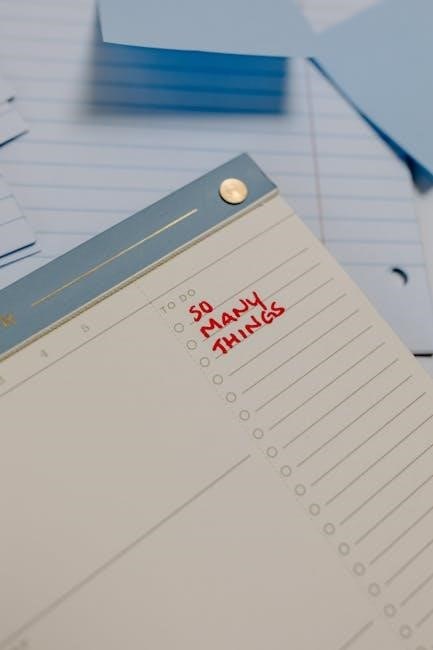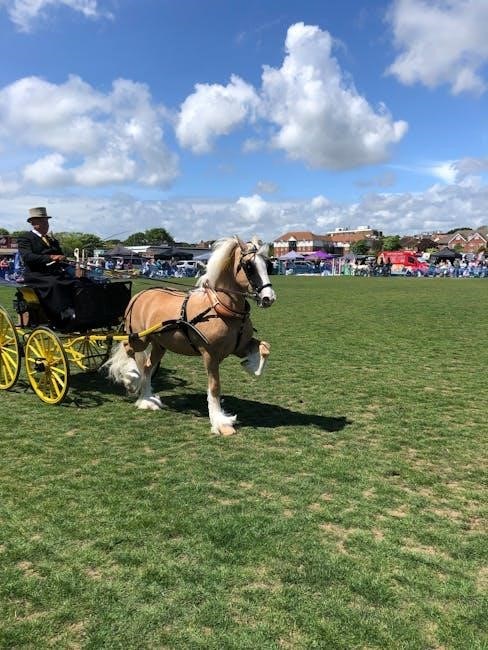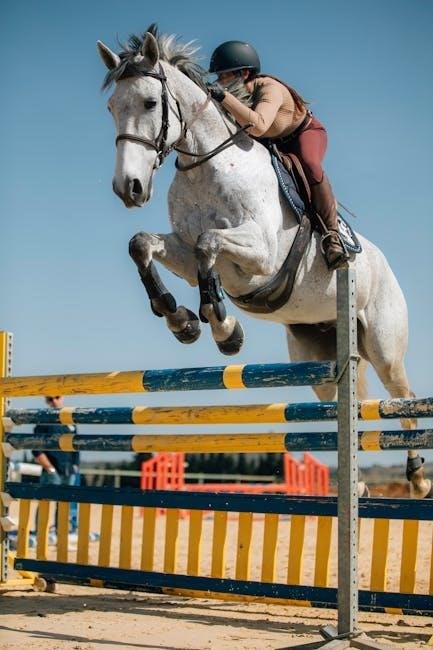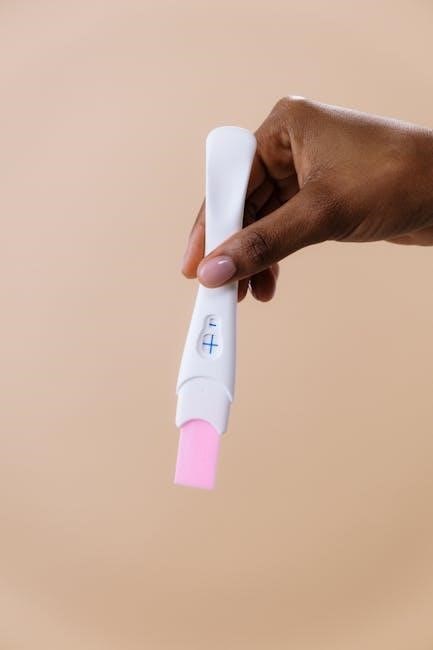
Overview of the Test
The Intro B Dressage Test is designed for riders and horses at the introductory level, focusing on basic skills and harmony. It includes walk and trot movements, transitions, and halts, with an emphasis on clear communication between horse and rider. Diagrams and visual aids are essential for understanding the test pattern and executing movements accurately. This test is a foundational step in dressage training, preparing competitors for higher-level challenges.
The Intro B Dressage Test is a foundational competition for riders and horses at the introductory level. It focuses on basic dressage skills, emphasizing harmony and clear communication between horse and rider. The test includes walk and trot movements, transitions between gaits, and halts. Riders enter the arena in working trot, perform a series of movements, and conclude with a halt and salute. Diagrams are provided to guide the sequence of exercises, ensuring clarity and precision. This test is designed to assess the horse’s willingness to respond to aids and the rider’s ability to execute movements smoothly. It serves as an excellent starting point for those new to dressage, preparing them for more advanced levels while fostering a strong partnership between horse and rider.
Purpose and Objectives
The primary purpose of the Intro B Dressage Test is to introduce riders and horses to the fundamentals of dressage, fostering a strong foundation in basic skills. It aims to assess the horse’s willingness to respond to aids and the rider’s ability to guide smoothly through a series of movements. The test emphasizes harmony, balance, and clear communication between horse and rider. By focusing on walk and trot exercises, it helps develop the horse’s suppleness and the rider’s ability to maintain consistent contact. The objectives include preparing competitors for higher-level tests, promoting proper dressage principles, and encouraging a positive experience for both horse and rider. This test is essential for building confidence and establishing a solid partnership, making it a cornerstone of dressage training and competition.
Key Features of the Intro B Test
The Intro B Dressage Test is characterized by its focus on foundational movements, designed to evaluate both horse and rider. Key features include the execution of working trot, rising trot, and transitions between trot and walk. The test also incorporates a halt and salute, emphasizing proper etiquette and control. Diagrams play a crucial role, providing visual guidance for movements such as entering in working trot, tracking left or right, and navigating the arena. The test is conducted in a standard 20m x 40m arena, with movements sequenced to assess balance, rhythm, and harmony. These features ensure the test is both educational and evaluative, helping riders and horses build a solid foundation in dressage. The clear structure and visual aids make it accessible for those new to the sport.

Understanding the Test Pattern
The Intro B Test pattern involves a 20m x 40m arena. Enter in working trot, track left, halt, and salute. Diagrams guide the sequence for clarity and smooth execution.
Arena Setup and Dimensions
The Intro B Dressage Test takes place in a 20m x 40m arena, marked with specific letters (A, B, C, etc.) to guide the sequence of movements. The setup ensures a clear path for the horse and rider to execute transitions and exercises smoothly. Diagrams provide a visual representation of the arena layout, helping riders understand where each movement should occur. The precise dimensions and letter placements are standardized to maintain consistency across all competitions. This structured environment allows riders to focus on the test’s technical and artistic requirements. Proper arena setup is essential for accurate judging and a fair evaluation of the performance. Diagrams further enhance understanding, ensuring riders can practice and perform the test with confidence and precision.
Sequence of Movements
The Intro B Dressage Test begins with the rider entering the arena in working trot, proceeding down the centerline without halting. The sequence includes transitions between trot and walk, with specific exercises such as turning left or right at designated letters. Riders must maintain a steady pace and rhythm, ensuring smooth execution of each movement. The test concludes with a halt and salute, demonstrating control and poise. Diagrams and call sheets provide a clear visual guide, outlining the exact pattern and timing for each exercise. This structured sequence allows judges to assess the horse’s responsiveness and the rider’s ability to guide seamlessly through the test. Proper execution of the sequence is crucial for achieving high scores and showcasing harmony between horse and rider.
Specific Exercises and Transitions
The Intro B Dressage Test includes specific exercises such as working trot, rising trot, and transitions to walk. Riders are required to perform smooth transitions between gaits, maintaining rhythm and balance. Turning exercises at key points in the arena, such as moving from centerline to the rail, are also included. Diagrams illustrate the exact movements, ensuring clarity for both riders and judges. The test emphasizes the importance of seamless transitions, such as halting squarely and promptly responding to aids. These exercises are designed to evaluate the horse’s willingness to obey and the rider’s ability to guide effectively. By focusing on precise execution, riders demonstrate their understanding of foundational dressage principles. Diagrams play a vital role in helping riders master these exercises and transitions with accuracy.

Walk and Trot Movements in Detail
The Intro B Dressage Test emphasizes the development of a clear, rhythmic walk and trot. Riders perform working trot and rising trot exercises, focusing on balance and harmony. Diagrams illustrate the correct execution of transitions between these gaits, ensuring smooth and precise movements. The test highlights the importance of maintaining a steady rhythm and clear communication between horse and rider during these foundational exercises.

Working Trot and Rising Trot
The working trot in the Intro B Dressage Test is a fundamental gait that demonstrates the horse’s balance and engagement. It is characterized by a steady rhythm and a moderate length of stride. Riders are required to sit in a light and balanced position, maintaining gentle contact with the reins. The rising trot, also known as the posting trot, is used to show the horse’s willingness to move forward and the rider’s ability to synchronize with the horse’s motion. Diagrams provide clear visual cues for executing these movements correctly, ensuring the horse remains supple and responsive to aids throughout the test. Proper execution of the working and rising trot is essential for achieving high scores in this introductory level.
Transition from Trot to Walk

The transition from trot to walk in the Intro B Dressage Test is a critical movement that showcases the horse’s obedience and the rider’s ability to communicate clearly. This transition should be smooth and seamless, with the horse responding promptly to the rider’s aids. The rider must maintain a steady seat and gentle rein contact, ensuring the horse does not rush or hesitate. Diagrams in the test pattern illustrate the exact point where this transition occurs, typically at the centerline or between specific markers. Proper execution demonstrates the horse’s willingness to adjust its pace and the rider’s control over the gait. This movement is essential for achieving harmony and precision, as it reflects the foundational skills required in dressage.
Halt and Salute
The halt and salute is a key element in the Intro B Dressage Test, demonstrating respect and discipline. The horse should come to a complete standstill, maintaining balance and alignment, with the rider sitting quietly in the saddle. The salute involves the rider removing their hat or making a respectful gesture, showcasing poise and control. Diagrams highlight the precise location for the halt, typically at the centerline near the judge’s booth. A well-executed halt and salute not only earns points but also leaves a positive impression. It is a moment to display the rider’s ability to communicate subtly with the horse, ensuring a polished finish to the test. This movement underscores the importance of precision and decorum in dressage.

The Role of Diagrams in the Test
Diagrams are essential for visualizing the Intro B Dressage Test pattern, providing a clear map of movements and transitions. They help riders and trainers understand the sequence, arena layout, and exercises, ensuring accurate execution. By illustrating the test’s structure, diagrams enable better preparation and practice, making the test more accessible and easier to follow. They are a valuable tool for achieving precision and harmony in performance.
Importance of Visual Representation
Visual representation through diagrams is crucial for understanding the Intro B Dressage Test. Diagrams provide a clear, graphical layout of the arena, movements, and transitions, making the test pattern easier to follow. They help riders and trainers visualize the sequence of exercises, ensuring accurate execution. For newcomers to dressage, diagrams are especially valuable, as they break down complex movements into manageable parts. By illustrating the flow of the test, diagrams enable riders to practice effectively, correct errors, and build confidence. They also serve as a quick reference during preparation, ensuring that the test is performed smoothly and harmoniously. Visual aids like these are indispensable for achieving success in the Intro B Dressage Test.
How Diagrams Aid in Understanding Movements
Diagrams play a pivotal role in clarifying the sequence and execution of movements in the Intro B Dressage Test. By visually mapping the arena and the required patterns, diagrams help riders and trainers understand the flow of the test. They break down complex movements into clear, step-by-step visuals, making it easier to memorize and execute the test accurately. For example, diagrams highlight transitions between gaits, such as trot to walk, and specify where these should occur in the arena. This visual guidance ensures that riders can focus on maintaining harmony and balance, rather than getting lost in the sequence. Additionally, diagrams assist in identifying key points, such as centerlines and circles, which are crucial for scoring. They also help riders and trainers identify potential mistakes and refine their practice, leading to a more polished performance.
Using Diagrams for Practice and Preparation
Diagrams are invaluable for riders and trainers preparing for the Intro B Dressage Test. They provide a visual representation of the test pattern, allowing riders to map out the arena and movements in advance. By studying diagrams, riders can memorize the sequence of exercises, such as transitions from trot to walk and the placement of halts. These tools also help identify key points like centerlines and circles, ensuring accuracy during practice. Trainers can use diagrams to break down the test into smaller sections, focusing on specific movements to improve execution. diagrams also aid in developing a mental plan, helping riders stay focused during the test. Regular practice with diagrams ensures a smooth and confident performance, making them an essential resource for achieving success in the Intro B Dressage Test.

Scoring and Judging Criteria
The Intro B Dressage Test is scored based on technical execution and artistic impression. Judges evaluate harmony, suppleness, and precision, penalizing errors like irregular rhythms or poor transitions. Each movement is assessed for quality and correctness, with penalties deducted for mistakes. The overall impression influences the final score, emphasizing the partnership between horse and rider.
Technical Execution of Movements
In the Intro B Dressage Test, technical execution is evaluated based on the precision and correctness of each movement. Riders are expected to perform a working trot, rising trot, and smooth transitions between gaits, such as trot to walk. The test includes halts and salutes, which must be executed squarely and calmly. Judges assess the horse’s suppleness, balance, and responsiveness to aids, ensuring movements are performed accurately and in rhythm. Diagrams provided in the test guide help riders understand the sequence and alignment of movements within the arena. Errors in technical execution, such as irregular rhythms or poor alignment, result in lower scores. The goal is to demonstrate a clear understanding of basic dressage principles while maintaining harmony between horse and rider.
Artistic Impression and Harmony
Artistic impression and harmony are key elements judged in the Intro B Dressage Test, focusing on the elegance and fluidity of the performance. Judges evaluate the horse’s willingness, suppleness, and balance, as well as the rider’s ability to guide smoothly and subtly. The partnership between horse and rider should appear seamless, with movements executed in a rhythmic and natural manner. Diagrams of the test pattern help riders visualize the flow of movements, ensuring a cohesive and aesthetically pleasing performance. While technical accuracy is crucial, the artistic aspect enhances the overall impression, showcasing the beauty of dressage. A harmonious test demonstrates the horse’s calm demeanor and the rider’s ability to communicate effectively, creating a polished and engaging display.
Penalties and Common Mistakes

In the Intro B Dressage Test, penalties are assigned for errors in execution, such as incorrect transitions, loss of rhythm, or insufficient suppleness. Common mistakes include rushing the trot, failing to maintain a clear working trot, or not halting squarely. Riders may also lose marks for poor alignment on the centerline or forgetting to salute; Diagrams of the test pattern help riders avoid navigational errors, such as turning incorrectly or miscalculating distances between movements. Additionally, horses that resist or show tension may incur penalties for lack of willingness. Careful preparation and practice, guided by diagrams, can help minimize these mistakes. Understanding the test requirements and focusing on smooth, precise execution are key to avoiding penalties and achieving a higher score.

Tips for Riders and Trainers
- Practice transitions between walk and trot to ensure smoothness.
- Use diagrams to visualize the test pattern and movements.
- Maintain consistent contact and clear communication with the horse.
- Focus on accurate halts and salutes for higher scores.
- Review feedback to improve performance and address weaknesses.
Preparation Strategies
Effective preparation for the Intro B Dressage Test involves a combination of practice, visualization, and review. Riders should thoroughly study the test diagram to understand the arena layout and movement sequence. Practicing transitions between walk and trot, as well as halts, is crucial for smooth execution. Regular training sessions with a focus on maintaining a consistent trot and clear communication with the horse are essential. Trainers can help by breaking down the test into smaller sections, allowing riders to master each movement before combining them. Using diagrams as a visual aid can enhance understanding and help riders memorize the test pattern. Additionally, reviewing feedback from previous performances or lessons can identify areas for improvement. Consistent practice and attention to detail will build confidence and readiness for the test.
Execution During the Test
During the Intro B Dressage Test, focus and calmness are key. Enter the arena in working trot, maintaining a steady pace and clear rhythm. Ride accurately along the centerline, ensuring smooth transitions between movements. Pay attention to maintaining the correct geometry of figures, such as circles and serpentines, as shown in the diagrams. The halt and salute at the end of the test should be precise and respectful. Keep your body posture aligned with the horse’s movement, communicating clearly through subtle aids. Avoid rushing or hesitating, as this can disrupt the flow of the test. Stay composed and let the horse respond willingly to your cues, showcasing harmony and partnership. By following the sequence faithfully, you can deliver a polished and confident performance.

Post-Test Review and Feedback
After completing the Intro B Dressage Test, a thorough review of the performance is essential. Analyze each movement’s execution, focusing on accuracy and fluidity. Feedback from trainers or judges can highlight strengths and areas for improvement. Use diagrams to visualize mistakes, such as incorrect transitions or misaligned patterns, and discuss how to refine them. Pay attention to the horse’s responsiveness and the rider’s aids. Constructive criticism should guide future practice, emphasizing harmony and precision. Reviewing the test with diagrams helps clarify expectations and aids in setting specific, achievable goals. This process fosters growth and readiness for advancing to higher levels of dressage competition.
The Intro B Dressage Test is a foundational yet effective assessment of a rider and horse’s skills. It emphasizes harmony, precision, and clear communication. Diagrams and visual aids play a crucial role in understanding and mastering the test’s movements. By focusing on walk, trot, and transitions, the test provides a clear path for progression. Riders and trainers can use feedback and diagrams to refine their techniques, ensuring a strong foundation for advancing to higher levels of dressage competition. This test is an excellent starting point for those new to the sport, offering a structured and achievable challenge.
Final Thoughts on the Intro B Test
The Intro B Dressage Test is an excellent introduction to the sport, emphasizing foundational skills and clear communication between horse and rider. By focusing on walk, trot, and transitions, it provides a structured pathway for development. Diagrams and visual aids are invaluable for understanding the test pattern and executing movements accurately. Riders and trainers can use these tools to refine techniques and build confidence. The test’s emphasis on harmony and precision makes it an ideal starting point for newcomers. With feedback and practice, competitors can master the Intro B Test and progress smoothly to higher levels, laying a solid foundation for their dressage journey. The availability of diagrams and resources ensures that the test remains accessible and achievable for all participants.
Progression to Higher Levels
The Intro B Dressage Test serves as a stepping stone to more advanced competitions. As riders and horses gain confidence and proficiency, they can move to higher levels such as Training Level or beyond. Diagrams and resources from the Intro B Test provide a clear understanding of the progression, helping competitors prepare for the increased complexity of movements. Riders develop a stronger bond with their horses, enhancing communication and precision. The skills mastered in the Intro B Test, such as smooth transitions and accurate geometry, lay the groundwork for tackling more challenging exercises. With consistent practice and feedback, competitors can seamlessly transition to higher-level tests, continuing their journey in the sport of dressage with a solid foundation.
